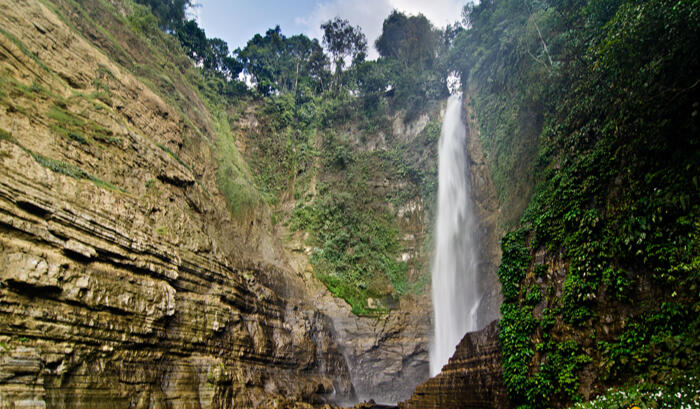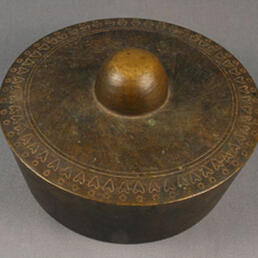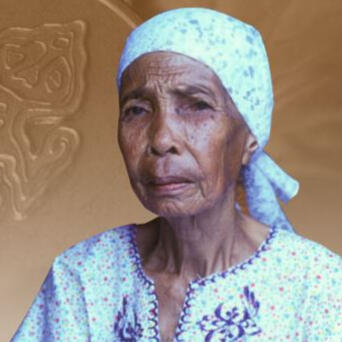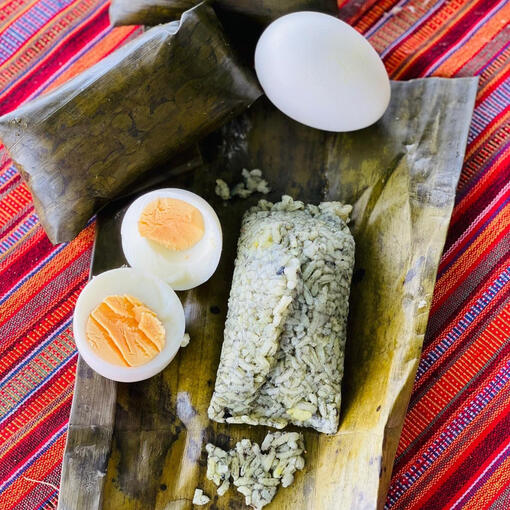PROVINCES
SOUTH COTABATO
South Cotabato is a known place with an interesting blend of culture, history, and tradition. They are known as a multi-religious and multi-racial culture, bringing festivals that remind us of a vibrant past. Up until now, the tribal people of South Cotabato have escaped modernizing influences. Through the years, they still live up to their ancestors' teachings, and their culture continues to develop and has found harmony with the nature around them. This is why this place is worth knowing about, and together, let’s dig deeper into it as we go further.

Seven Falls of Lake Sebu
Tourist Spots
We have the Lake Holon, Surallah Tri-People Monument, Mt. Matutum, Tupi Tarisier Sanctuary, Lake Sebu, Seven Falls of Lake Sebu, South Cotabato Community Museum, Siok Falls, Lang Dulay Tnalak Weaving Center, and T’boli Homestay.
Language
The province is home to more than 20 different dialects, and majority of South Cotabatenos are bilingual, being able to communicate in Hiligaynon and/or Cebuano in addition to Tagalog and English. Ilocano and Maguindanao are two other languages used. Additionally, native tribes like the T'boli and B'laan speak their languages.Data shown for the most spoken dialect in South Cotabato:
| Hiligaynon | 52.4% |
| T’boli | 15.6% |
| Cebuano | 14.2% |
| Ilocano | 4.6% |
| Maguindanaoan | 3.6% |
| Karay-a | 1.6% |
| Tagalog | 1.5% |
Basic LanguagesGood morning - Maayong aga!
Good afternoon - Maayong hapon!
Good evening - Maayong gab-i!
How are you? - Kamusta ka na?
Where you going? - Diin ka makadto?
How much is this? - Tagpila 'ni?
Culture

T'boli
According to a T'boli legend, the T'boli are descended from the great flood survivors. A guy named Dwata forewarned the populace of a coming massive flood. With the exception of La Bebe and La Lomi and Tamfeles, and La Kagef, the tribe was unwilling to listen. Dwata advised them to seek refuge inside a bamboo that was so large that they could all squeeze inside to survive the flood. According to the narrative, the first pair are descended from the T'boli and other highland ethnic groups, while the second couple are related to other indigenous Filipino communities.
T'boli Tribe, is the most well-known tribe in South Cotabato. This tribal group still practices traditional living, much like their long-gone predecessors did. T'boli set themselves apart from other tribal groups by wearing brightly colored clothing, bracelets, and earrings. This tribe is renowned for its intricate beadwork, gorgeous fabrics, and exquisite brass decorations. The T'boli culture is influenced by nature; as a result, their dances often mirror the movements of birds and monkeys. Although the T'boli have a vibrant musical tradition and use a wide range of instruments, their songs and music are not just for enjoyment. The songs of the tribe act as a living link to their ancestors and a storehouse of proverbial knowledge.
T'nalak, or T'boli sacred cloth, is the most well-known T'boli craft and one of the tribe's traditional textiles. Another legend claims that T'nalak weaving was taught in a dream by a goddess named Fu Dalu and that women learn this ethnic and religious practice based on tribal motifs and textile patterns in their dreams.
Famous Arts

T'nalak
The rich cultural heritage may be recognized through their inventions, which exhibit the tribe's collective imagination and cultural meanings.
PROVINCES
TAWI-TAWI

Bud Bongao Peak
Tawi-Tawi, the Philippines' southernmost province, is regarded as one of the country's most off-the-beaten-path places. Tawi-Tawi is home to a diverse and vibrant culture that has thrived and been conserved for hundreds of years; tourists to this province are guaranteed to have a one-of-a-kind experience.
Tourist Spots
Panampangan Island is considered the longest sandbar in the Philippines. Bud Bungao Peak has the biodiversity of Tawi-Tawi is represented by Bongao Peak. The majority of its slope is covered in dense rain forests. These are home to hundreds of monkeys, some of whom are white and others are brown. Badjao Village are known for weaving handcrafted mats with colorful and elegant designs is one of their sources of income. Tourists will be able to learn about their fascinating culture and way of life.
Language
In Tawi-Tawi, Tausug is primarily spoken, although many people also converse in the local "Sama" language, particularly on the island of Sitangkai. The majority of the population of Tawi-Tawi also speaks English, Chavacano, Cebuano, Tagalog, Yakan, and Yakan. Many inhabitants are also fluent in Malay.
Basic LanguagesGood morning - Marayaw maynaat!
Good afternoon - Marayaw mahapun!
Good evening - Marayaw dum!
How are you? - Maunu-unu kaw?
Where you going? - Hawnu na kaw??
How much is this? - Pilasin halga niya ini?
Culture
The Sama are the original inhabitants of the Tawi-Tawi archipelago. The term ‘Sama’ is derived from the word sama-sama meaning togetherness. They are a peaceful and united people. They rarely resort to physical violence, preferring instead to discuss problems among themselves. Strangers are viewed with suspicion by the Sama. However, they can be easily befriended after the outsiders have established trust with them. These people are often friendly and welcoming. They are God-fearing people who only worship Allah.They are originally from Johore (a Malaysian state).Their forefathers are said to have supernatural abilities that allowed them to summon Jinn spirits (also anglicized as ‘genies’) to do things for them. These spirits are unseen by spirits that are thought to be amorphous. Good fortune comes to believers who make offerings to their ancestors. They are rich in knowledge of spiritism.
Famous Arts

Kulintang
Tawi-Tawi is well recognized for its excellent weaving where unusual colorful mats with intricate geometric patterns are hand-made. Mat weaving is only done by women among the Sama-Bajau, from the harvesting of pandan leaves to the execution of the design.
Gong and kulintang are important Sama musical instruments. The ringing of gongs warns able-bodied Sama to brace themselves for battle. The sound of musical instruments accompanies the performance of a Pangalay dance (a traditional dance form in Sulu) during quiet times.Shipbuilding has a long history in Sulu, extending back to its precolonial inhabitants, with the Sama people regarded as some of the most talented craftsmen.
Haja Amina Appi of Ungos Matata, Tandubas, and Tawi-Tawi is regarded as the master mat weaver in the Sama indigenous community of Ungos Matata. Her multicolored mats with intricate geometric designs demonstrate her fine sense of design, proportion and symmetry, and color sensitivity.
Known People

Haja Amina Appi
Her one-of-a-kind multicolored mats are shielded by a plain white outer mat that also acts as the mat's backing. Her beautiful works can take up to three months to complete.
Foods

Junay

Agal-Agal
Junay is steamed rice with coconut milk and toasted coconut. The rice is wrapped in small packets of banana leaves, like suman.Tawi-Tawi is known as the "Seaweed Capital of the Philippines," and they have an Agal-Agal Festival every September to highlight their main industry. Agal-agal is made with onions, tomatoes, and soy sauce and pairs well with fried or grilled fish.
RESOURCES
REFERENCES
Aklan Travel Blog. (2017, July 26). Culture. https://aklantravelblog.wordpress.com/culture/Andico, F. L. (n.d.). The Lowland Cultural Community of Pangasinan. GOVPH. https://ncca.gov.ph/about-ncca-3/subcommissions/subcommission-on-cultural-communities-and-traditional-arts-sccta/northern-cultural-communities/the-lowland-cultural-community-of-pangasinan/Bocarillo | Kawaling Pinoy Tasty Recipes. (n.d.). https://www.kawalingpinoyrecipe.com/native_delicacies/bocarillo.htmCinco, M. C. L., Makalintal, L. G. M., Montemor, D. R. C., & Sawali, J. A. (2014, August 20). Famous Delicacies of Selected Municipalities in the Province of Laguna: A Tourist Attraction for Culinary Tourism. College of International Tourism and Hospitality Management. https://research.lpubatangas.edu.ph/wp-content/uploads/2014/08/JTHR-Famous-Delicacies.pdfDela Cruz, H. (2020, May 13). Aklan's food delicacies. AKLAN'S FOOD DELICACIES. https://bertietalimongan.wordpress.com/de Jong, R. (2008, October 23). The T'boli Tribe of South Cotabato. ThingsAsian. http://thingsasian.com/story/tboli-tribe-south-cotabatoExpert World Travel. (2021, May 28). Coconut Festival. https://expertworldtravel.com/philippines/coconut-festival/?fbclid=IwAR3J7ASofA5d1T6TwzF6WpGJ2Keb6dpjdVYnscmS51frSSFYiNf4cGCHE3wGo, M. (n.d.). Tawi-Tawi Travel Guide: The Southernmost Island Province in the Philippines. Guide to the Philippines. https://guidetothephilippines.ph/articles/ultimate-guides/tawi-tawi-travel-guideGuide to the Philippines. (n.d.). Hundred Island National Park. https://guidetothephilippines.ph/destinations-and-attractions/hundred-island-national-park?fbclid=IwAR1t42tcZcHXf4KwTNR2VR2tHQOYnEa5RkdshzFIf69BzuaBJ-X_Ag7QA_MHerrington, D. (n.d.). Tawi-Tawi Culture, Customs And Traditions Living In The Philippines https://www.livinginthephilippines.com/culture-and-people/philippine-culture/culture-and-traditions/1288-tawi-tawi-culture-customs-and-traditions#It’s More Fun in the Philippines. (n.d.). About Leyte & Samar. https://itsmorefuninthephilippines.co.uk/leyte-samar/Maches, D. (2020, April 2). Top 15 South Cotabato Tourist Spots (UPDATED): Best Places to Visit. Daniel's Eco-Travels. https://danielsecotravels.com/south-cotabato-tourist-spots/Maches, D. (2020, April 6). 20+ Tawi-Tawi Tourist Spots (UPDATED): Best Places. Daniel’s Eco-Travels. https://danielsecotravels.com/tawi-tawi-tourist-spots/Maentz, J. (2015, November 10). Tawi-Tawi – Into the Sulu Archipelago. Jacob Maentz Photography. https://jacobimages.com/2015/11/tawi-tawi-sulu-archipelago#National Commission for Culture and the Arts. (2019, September 3). GAMABA: Haja Amina Appi. https://ncca.gov.ph/about-culture-and-arts/culture-profile/gamaba/national-living-treasures-haja-amina-appi/Patrick. (2022, October 12). Get to know the Aklan Province in the Philippines. Discover The Philippines. https://www.discoverthephilippines.com/aklan-province-philippines/#fast-factsSantos, K. (2013, March 5). Food Trip: Tawi-Tawi. Travel Up. https://www.traveling-up.com/food-trip-tawi-tawi/South Cotabato News. (n.d.). Trivia: Most Spoken Dialect in South Cotabato. https://www.southcotabatonews.com/2013/05/trivia-most-spoken-dialect-in-south.htmlThe Pinoy Warrior. (n.d.). Pina cloth in Kalibo, Aklan. http://www.thepinoywarrior.com/2012/08/pina-cloth-in-kalibo-aklan.htmlThe Official Website of the Province of Pangasinan. (n.d.). History. https://www.pangasinan.gov.ph/the-province/history/?fbclid=IwAR2chrKo6f34DvqQPHLjaiUfeMhnH28NZqDOlBjLbr-VOl8IFX7aHKEPkKAUniversity of Hawai’i Center for Philippine Studies. (n.d.). Dr. Jose P. Rizal. http://www.hawaii.edu/cps/rizal.html?fbclid=IwAR0kKj6eJdALG8oUwYcu8iW7DVk58qizX7te0yuqPzE0Pbe9R7BqRMueVmUWikipedia. (2022, August 26). Leyte. https://en.wikipedia.org/wiki/LeyteYodisphere.com. (n.d.). Pangasinense People of Pangasinan: History, Culture and Arts, Customs and Traditions [Philippines]. https://www.yodisphere.com/2022/09/Pangasinan-Pangasinense-Culture-Traditions.html#:~:text=Pangasinan%20abounds%20in%20handicrafts%20and,handicrafts%20made%20of%20marsh%20grasses


